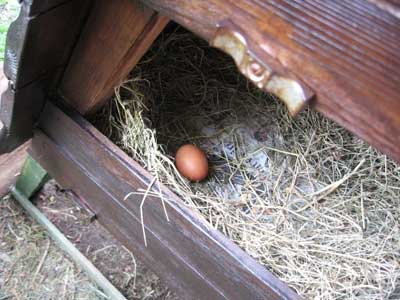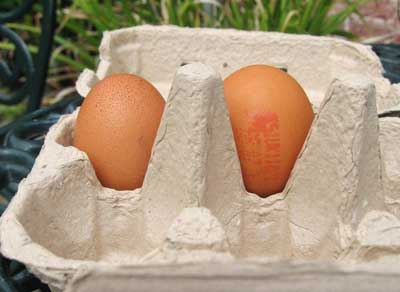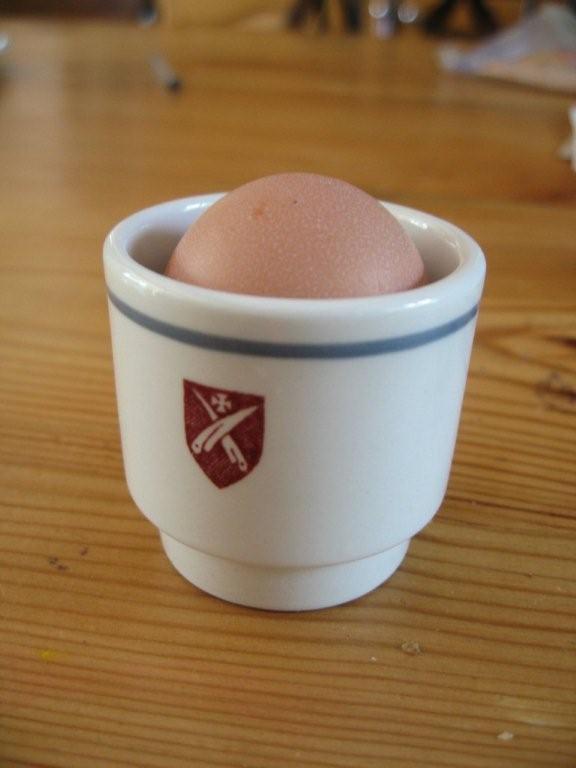Hen-mania Part 3: The first egg!
By Ruth D’Alessandro, The Wildlife Gardener The Wildlife Gardener had a strange feeling that there might be something in the henhouse nestbox this morning. How right I was!

Yes, the WG hens’ first egg! For just a second as I opened the hatch, I felt like Howard Carter peering through the hole in Tutankhamun‘s tomb: a’wonderful thing‘. Most probably from Mademoiselle Pompidelle, the senior hen, a big, blousy, orange Diana Dors of a bird who has taken to sleeping in the nest box rather than on the perch. Still, this gives the other, skinnier hens a bit more room. The pullets are now 20 weeks old, and, as the farmer said, they should start laying eggs round about now. I was expecting a very tiny first egg, but as you can see, compared with a supermarket medium free range one, M’elle Pompidelle has made a darn fine first effort:

So how are eggs actually produced? Whether there is a cockerel around to fertilise them or not, a domestic hen lays an egg pretty much every day. She ovulates, producing a cell called an oocyte from her ovary, which later becomes the yolk. The oocyte is then released into the oviduct, which, in a hen, is a long spiralling tube. The oocyte travels down to the part of the oviduct called the magnus. There, the yolk is covered with a membrane (the vitelline membrane), layers of albumen (the egg white) and given some structural fibres (chalazae). As the egg continues its journey down the oviduct, it rotates continually within the spiral tube. This rotation twists the chalazae into two’ropes’ top and bottom that hold the yolk centrally within the egg white. The lower part of the oviduct is where the eggshell is deposited, just before it is laid. Eggshell is made up of calcite, a crystalline form of calcium carbonate. It takes a day for an egg to make its entire journey through the oviduct. Some first eggs have whites but no yolk, and are known as’wind eggs’. Great for Californians with their egg-white omelettes. This happens as the immature laying mechanism may not produce a yolk, but still go through the other layering processes within the oviduct. M’selle Pompidelle’s little egg had a very round, very yellow and very delicious yolk. So what did it taste like? We were so excited frying our first egg that I clean forgot to get the camera out to record that great moment. So, in the best traditions of Radio 4’s Food Programme I’ll describe it instead. The bright yellow yolk stood raised in a 2 cm high mound of egg white not unlike jelly in a jelly mould. This thick albumen is the sign of a very fresh egg: it doesn’t spread out all over the bottom of the frying pan. The towering egg was quite hard to cook to wobbly perfection, being used to eggs flattening out, but I managed it and presented it to Junior Wildlife Gardener no.2 in a soft bread roll as a thank you for all her help building the chicken run. The runny yellow yolk had a surprising, intense egginess, far stronger and richer than any shop-bought egg. The bar for flavoursome eggs has been set very high now. This egginess must be due to the pampered WG hens’ diet: in addition to commercial layers’ pellets (which they don’t really enjoy) and poultry corn (which they do), they have fresh grass, clover, weeds: chickweed (what else?) ground elder, milk thistles, groundsel and dandelions, bolted radish and chard plants, soft fruit, slugs and aphids. They have lots of clean, fresh water and grit too for calcium and for grinding up food in their crops. They pick up enough grit scratching the earth in their big run, but I keep eggshells, bake them, then crush them up into their feed to supplement their calcium. All this should ensure that the’intense egginess’ continues. Must go now, as I’ve another funny feeling that there’s something in that nestbox again… Update: there was!

- Spurn Spawn! - 26th February, 2014
- Bluebells on wheels: axles of evil? - 2nd February, 2011
- Raising the ba: Wildlife and the Ancient Egyptian Book of the Dead - 8th January, 2011

According to Hugh-Fearnley-Whittingstall, the commercial egg-laying hybrid breeds (Rhode Island Reds, ISA Browns and Warrens (ours)) are tough little things, bred to endure battery conditions. If you give these breeds a nice life, they are strong and healthy. Tell your mum.
That’s great to see! I am most jealous. Am trying to persuade my mother to get the hens she desperately desires, but she insists they are prone to hundreds of illnesses…..
Congratulations on the first eggs, though I imagine it was the chickens that did the work, all you did was coddle them and raise them and build them a home…
I must admit some envy, but at least I can live vicariously through your experiences. I was wondering how the egg already got a supermarket stamp on it, but then I realized it was just for comparison. I thought you had really efficient chickens already to sell their own produce.